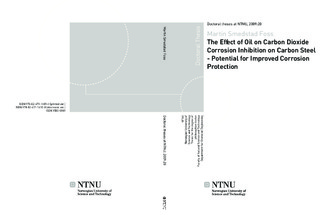| dc.contributor.author | Foss, Martin Smedstad | nb_NO |
| dc.date.accessioned | 2014-12-19T13:23:17Z | |
| dc.date.available | 2014-12-19T13:23:17Z | |
| dc.date.created | 2010-06-09 | nb_NO |
| dc.date.issued | 2010 | nb_NO |
| dc.identifier | 326917 | nb_NO |
| dc.identifier.isbn | 978-82-471-1409-4 (printed ver.) | nb_NO |
| dc.identifier.isbn | 978-82-471-1410-0 (electronic ver.) | nb_NO |
| dc.identifier.uri | http://hdl.handle.net/11250/248202 | |
| dc.description.abstract | The search for robust and cost efficient ways to prevent internal corrosion of carbon steel piping and equipment in oil and gas production and transportation has lead to the development of highly sophisticated CO2 corrosion inhibitor products. This thesis studies oil wetting and corrosion inhibitor performance on bare steel and steel with corrosion product deposits on the surface, in the presence of a refined, low aromatic hydrocarbon oil. Three surfactants were used in the experiments; two commercial inhibitor base chemicals; an oleic imidazoline salt (OI) and a phosphate ester (PE), and cetyl trimethyl ammonium bromide (CTAB), a well characterized quaternary ammonium compound. Adsorption characteristics of the inhibitors on corroding iron and FeCO3 particles were also studied.
Polarization resistance (PR) and electrochemical impedance spectroscopy (EIS) techniques were used to study the effect of the oil on the performance of the inhibitors. The performance testing was done on corroding carbon steel without any surface deposits and on carbon steel with either ferrous carbonate (FeCO3) or ferric corrosion products on the surface. The results showed that the addition of oil in the inhibitor tests had a significant, positive effect on the performance of the two commercial corrosion inhibitors; decrease in corrosion rate of about one order of magnitude compared to the rate without oil was found. Based on the EIS data it was concluded that the improved performance was caused by a modification of the inhibitor film and not the formation of a macroscopic oil film on the steel surface. Indications of oil wetting of the steel surface were only found when ferric corrosion products were present and OI was used as the inhibitor. No such effects were seen on bare steel or on FeCO3 covered surfaces.
Contact angle measurements and dispersion tests were used to investigate the effect of the inhibitors on the wettability of the three types of surfaces when they were exposed to water and oil. Both the behavior of an oil droplet on an already water-wet surface and a water droplet on an already oil wet surface were investigated to determine the ability of the inhibitors to alter the affinity of the surface to water and oil respectively. The results indicated the no hydrophilic to hydrophobic transition occurred on bare steel and FeCO3 covered steel. The testing on surfaces with ferric corrosion products revealed that a waterwet to oil-wet transition was possible on the ferric deposits using both PE and OI as inhibitor. The effect was, however, significantly stronger with OI than with PE. It was also found that the addition of the two inhibitors enhanced the hydrophobic behavior of an already oil-wet surface for both bare steel and steel with FeCO3 deposits. Water droplets entrained in the oil was in these experiments not able to spread on the steel surface.
Electrophoresis measurements were used to determine influence of the three inhibitors on the zetapotential of FeCO3 and corroding iron particles. The tendency of the inhibitors to adsorb on surfaces with the same charge as the head group of the inhibitor was investigated. The focus in the testing on corroding iron was to determine the suitability of zetapotential as a method for investigating surface potential of corroding surfaces. It was found that the inhibitors adsorbed on iron carbonate regardless of the surface charge on the iron carbonate. On iron particles the experiments indicated that measurements of the surface potential of corroding particles could only be done when the corrosion rate had been reduced significantly using corrosion inhibitors. | nb_NO |
| dc.language | eng | nb_NO |
| dc.publisher | NTNU | nb_NO |
| dc.relation.ispartofseries | Doktoravhandlinger ved NTNU, 1503-8181; 2009:20 | nb_NO |
| dc.title | The Effect of Oil on Carbon Dioxide Corrosion Inhibition on Carbon Steel - Potential for Improved Corrosion Protection | nb_NO |
| dc.type | Doctoral thesis | nb_NO |
| dc.contributor.department | Norges teknisk-naturvitenskapelige universitet, Fakultet for naturvitenskap og teknologi, Institutt for kjemisk prosessteknologi | nb_NO |
| dc.description.degree | PhD i kjemisk prosessteknologi | nb_NO |
| dc.description.degree | PhD in Chemical Process Engineering | en_GB |

